Old Dubai: a quick visit
While I didn’t do any shopping in Dubai, I did manage a quick walk around the Bastakiya District: also known as Old Dubai.

Dubai was originally a small port that made its living from pearl diving, fishing and trade, especially with Iran. Besides the nomadic Bedouins, who lived in tents, the populations who settled here lived in palm-thatched mat huts.
Traditional architecture in Old Dubai
Early in the 20th century, Persian merchants prospered in Dubai, building the neighborhood called Bastakiya or, more recently, the Al Fahidi Historical Neighborhood. Their more substantial houses generally had two floors, made of adobe and built around inner courtyards. Many also had open balconies or roof spaces that, like the courtyards, allowed the women and their families privacy and a cooling breeze in the heat of summer.
A unique feature of these houses was their barajils, wind towers. Square structures rising well above the roof, they are cleverly designed to channel the breezes down into the living spaces below: early air conditioning. If you’re interested in the details of Dubai’s architectural history, this blog gives a clear explanation.
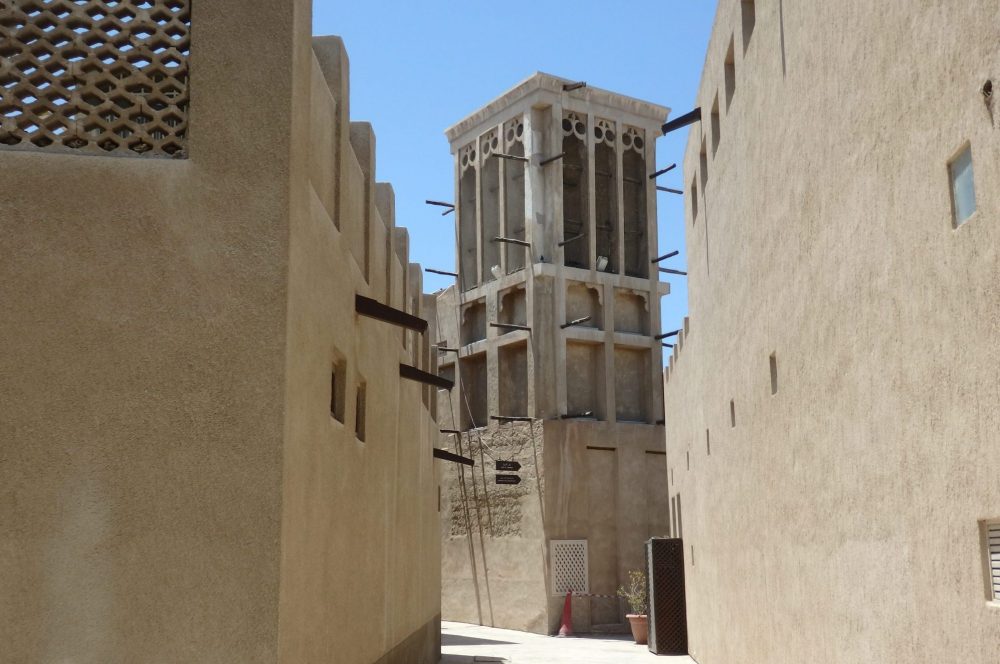
The Bastakiya neighborhood fell into disrepair. In the 1970s, many traditional homes were torn down to make way for the modern city of today.
Fortunately, the rest of the old houses were saved and bought by the government. Since the turn of the 21st century, renovations are ongoing in the interest of preserving local heritage, as well as to attract tourists.
For lots more things to do in Dubai, read this post: One Day in Dubai: what to do?
Art galleries in Old Dubai
The first art gallery in Bastakiya came about due to the efforts of Alison Collins, founder of Majlis Gallery. Collins leased a dilapidated traditional home, renovated it and moved in, inviting artists to display their work at regular “soirees.” Eventually she and her family moved out to turn it into a showcase for local artists. Its tree-shaded courtyard alone is worth the visit.
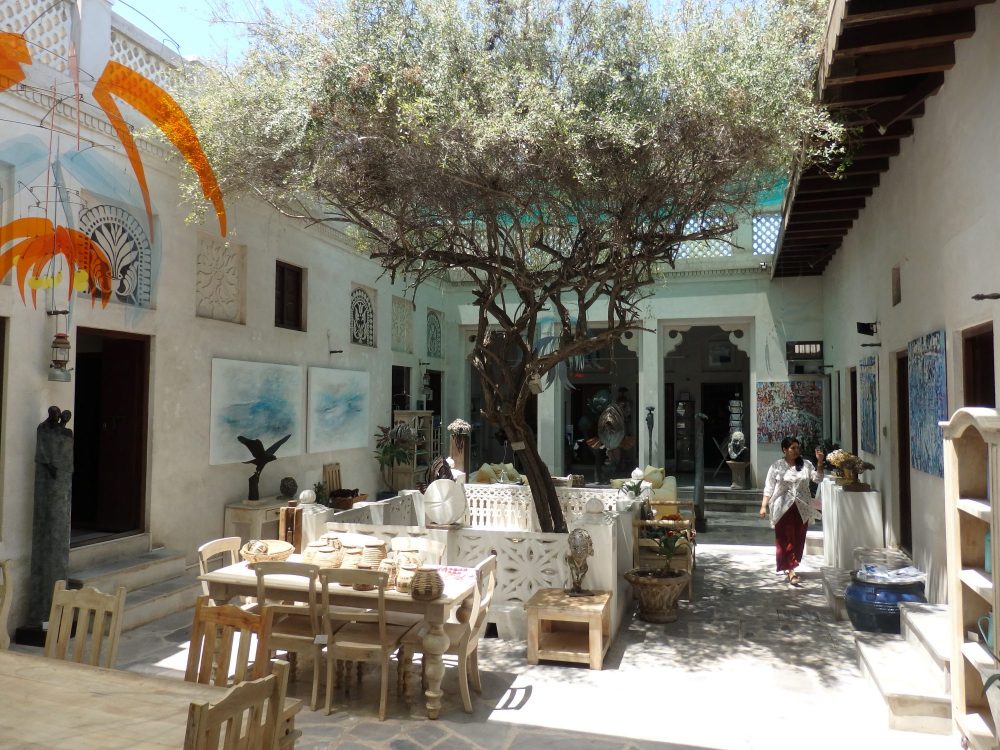
Wandering the narrow streets of this neighborhood reveals more galleries. One interesting one is Mawaheb from Beautiful People, which provides a safe environment for adults with special needs to express themselves through art. Visitors are welcome to have a cup of coffee in the courtyard and watch the artists at work. The quality of many of the works on display impressed me.
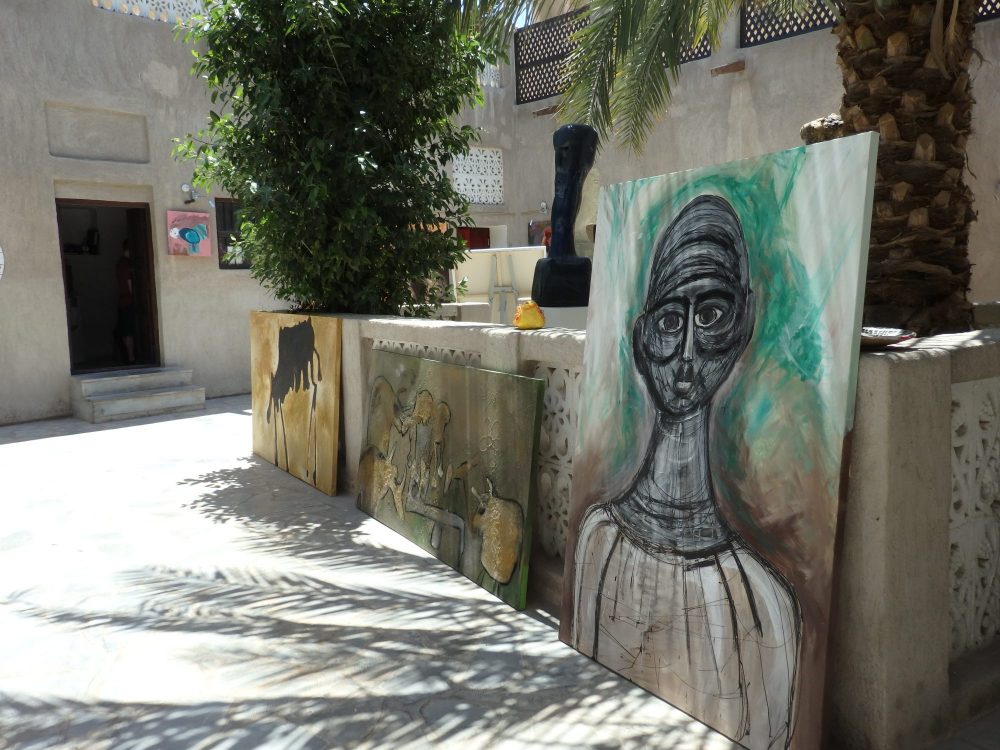
Museums of Old Dubai
I could only spare a couple of hours. For that reason, I didn’t get to see the many small museums housed in Bastakiya and the neighboring Shindagha area of Old Dubai. I spotted many:
- The Dubai Museum is the most visited and well-known, and is housed in the Al Fahidi Fort, which dates from 1787. It covers all aspects of Dubai history, culture, and natural history.
- Sheikh Saeed Al Maktoum House is the only one I managed to visit, and is a beautiful example of traditional Dubai architecture, but grander in scale than most of the Persian-built homes.
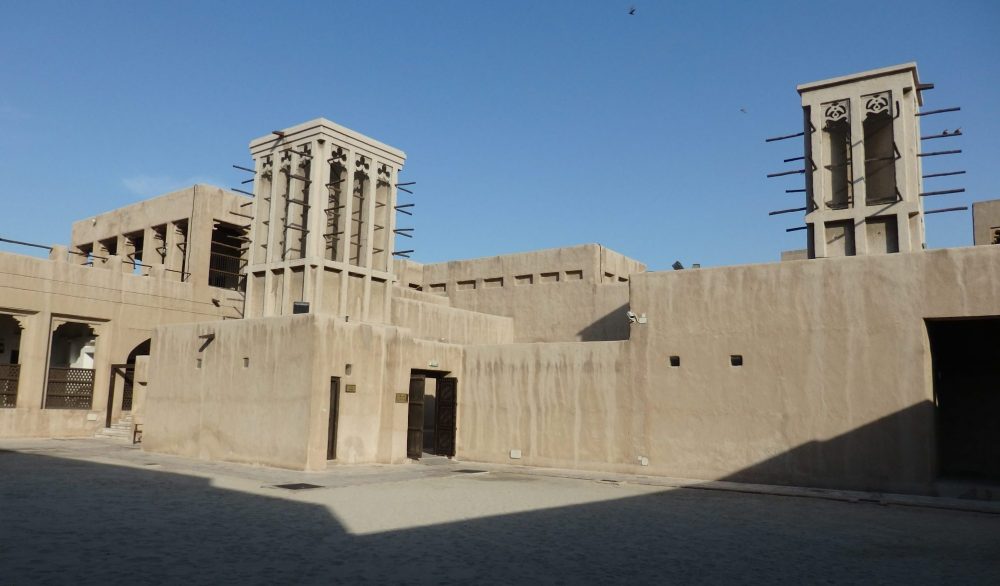
- The Jumaa and Obaid Bin Thani House is near the Sheikh Al Maktoum House. Besides being one of the oldest houses in the neighborhood, it now holds an exhibition of Arabic calligraphy.
- The Coin Museum, in another traditional house, is a must, I would think, for any coin collector visiting Dubai.
- The Camel Museum, near the Sheik’s house, is filled with information about camels and their place in Dubai’s history.
- Dubai Coffee Museum sounds to me like a coffee shop with a few rooms of information about coffee.
- The Diving Village covers Dubai’s maritime, pearl-diving and fishing history.
I stopped into the Heritage Village not far away (I think the Diving Village and the Heritage Vllage may be parts of a single organization), staying just long enough to buy a khameer bread from a woman dressed in traditional Bedouin gear. At busier times artisans create traditional crafts for tourists and demonstrate the original way of life of the inhabitants of Dubai.
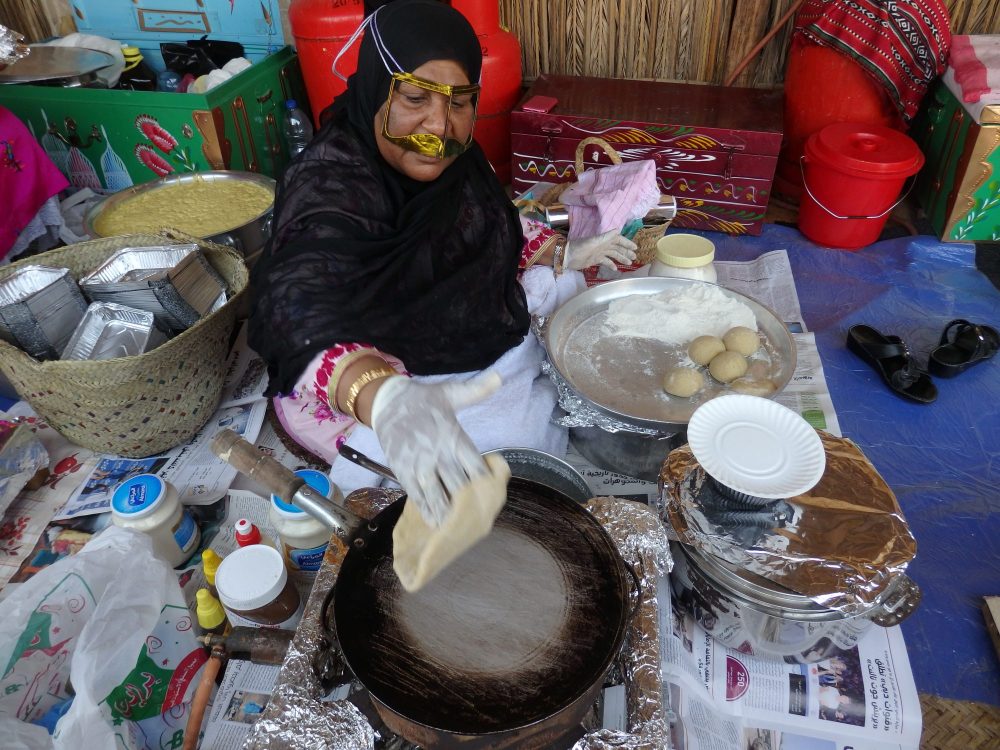
This list of sites isn’t even complete, and doesn’t include other small museums and historical houses in other areas like Deira, across the Creek. As you can imagine, you could easily spend many days exploring the history of Dubai in depth.
Have you visited any of Dubai’s historical sites or museums? What would you recommend as a “must-see” for the next time I go there?

I am a co-host of Travel Photo Thursday. If you have a travel blog and want to join in, do the following:
- Add your blog to the linkup, using the link below.
- Put a link back to this page onto your blog post.
- Visit at least a few of the other blogs in the linkup, comment on them, share them and enjoy them!
If you don’t have a travel blog yourself, you can still click on any of the blogs below and visit them!



Hi Rachel! Old Dubai looks fascinating. I think it must be much more interesting than the ultra modern city it has become. I love your shot of the art on display. The canvas of the woman is most intriguing. Thanks for hosting this week. #TPThursday
Yes, that was my favorite too! They’re producing such good work there! And yes, Old Dubai is much more interesting than modern Dubai!
I’ve flown via Dubai but never stopped because it didn’t appeal to me. I love the look of the old district though. I’m happy that you pointed out the wind towers – what a good idea in their climate.I like the initiative to bring artists with disability into the spotlight.How interesting is the traditional Bedouin face covering! I’ve not seen the face piece before.
Me neither! She and the other two women there all had it riding kind of low, so it looked like a mustache, which I don’t think was the intention! I’d recommend stopping over in Dubai at least for a day or two next time!
Rachel, I think this is a very refreshing post about Dubai. We tend to read and see pictures of th emodern areas of the city (which looks nice, I cannot deny it). But, I would like to stroll thru the old areas you have presented in here. I didn’t know there were so many small museums. It would be nice to stop by a couple of them.
If I’d had more time, I would have loved to visit and write about a couple of the more obscure ones: a horse museum? A camel museum? I do love quirky little museums best! I may be back in Dubai next spring again, so I’ll try to plan in a bit more time!
Bastakiya is my favourite part of Dubai. Love the old wind towers – and there’s a garden cafe there which serves the best breakfasts and juices. Also really enjoyed visiting the cultural centre there. Much more to Dubai than shopping.
Yes, I know! And yet shopping is what most people associate with Dubai.
Old Dubai looks brilliant and so much more interesting than the big brash new Dubai. We are stopping here on our world cruise, so you’ve given me some great ideas for things to do and see that might not be at once obvious.
Go to Old Dubai! And, for the other end of the spectrum, you could go up in Burj Khalifa.
I loved old Dubai – so much more interesting than the new bits! The old souk is worth wandering around and I liked taking the water taxi across the Creek to Deira.
Yes, a souk is always interesting!
I’ve visited Old Dubai and especially enjoyed the art galleries. Did you happen to see this guy when you were there?, https://youtu.be/ewWQ3hRiqMQ
No, I didn’t, but thanks for sharing the video!
Thanks for introducing me to Old Dubai. This looks more like the “Real Dubai!”
And yet it’s only a very small part of the city, and very few, if any, people live there.
Thanks for an informative post about old Dubai, which is not what usually gets covered by travel bloggers. Thanks for the posting!
It’s the kind of thing I like posting about best!
I had just assumed that anything old had been bulldozed to make way for the modern skyscrapers. I’m glad that they are preserving some of their heritage. I wonder how those wind towers would measure up to today’s air-conditioning. I guess it was better than nothing. How was the bread?
I think most of the wind towers have been closed off inside to allow the space to be air conditioned, but before air conditioning was invented I’m sure it was better than nothing. The bread was tasty: it had sesame seeds and a bit of mild cheese on top.